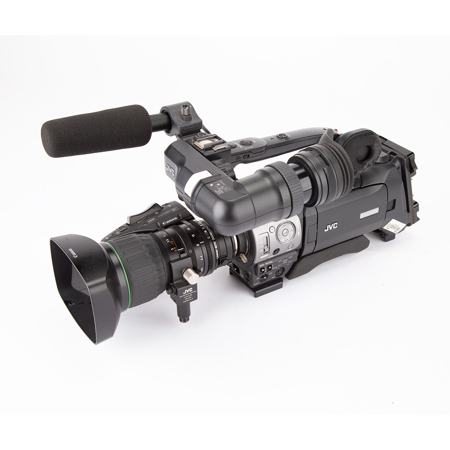


















See Options
2 Year
$106.99
3 Year
$166.99
4 Year
$227.99
Need help? Ask our experts.
Review Summary
1/3" Progressive scan 3CCD
Canon F1.6, 14x, f=4.4-61.6mm (35mm conversion:32 to 448mm)
1/3" bayonet system
82mm
1/6 to 1/10000, EEI
0dB, 3dB, 6dB, 9dB, 12dB, 15dB, 18dB, ALC
OFF, +1/4 ND, +1/16 ND
1.25lx (typical) (1920x1080 mode, F1.4, +18dB, with 8-frame accumulation)
Internal sync: built-in SSG
4.3" LCD, 800 x 480 (WVGA, 410,000 pixels)
0.45" LCOS, 1,226,000 pixels (852 x 480 x 3)
SDHC memory card (Class 6 or Class 10), 2 slots
Video codec: MPEG-2 Long GOP
File Format: Quick time format for Final Cut Pro/mp4 file format
HQ mode: VBR, 35Mbps (1920 x 1080i 50/60, p24/25/30) MPEG-2 MP@HL
SP mode: CBR, 25Mbps (1440 x 1080i 50/60) / 19Mbps (1280 x 720p 24/25/30)MPEG-2 MP@H-14; 19Mbps (1280 x 720p 50/60) MPEG-2 MP@HL
DV compression 4:1:1(NTSC: GY-HM750U/CHU only)/4:2:0(PAL: GY-HM750E/CHE), 8-bit, 25Mbps
NTSC setting HD HQ mode:
1920x1080/59.94i, 29.97p, 23.98p, 1440x1080/59.94i (MOV only), 1280x720/59.94p, 29.97p, 23.98p
HD SP mode: 1440x1080/59.94i, 1280x720/59.94p 29.97p, 23.98p
NTSC SD mode: 480/59.94i (GY-HM750U/CHU only)
PAL setting HD HQ mode: 1920x1080/50i, 25p, 1440x1080/50i (MOV only), 1280x720/50p, 25p
HD SP mode: 1440x1080/50i, 1280x720/50p, 25p
PAL SD mode: 576/50i (GY-HM750E/CHE only)
HD HQ 720p mode - NTSC setting: 10/12/15/20/24/30/40/48/60fps / PAL setting: 10/12.5/20/25/40/50 fps
HD: Linear PCM 2ch, 48 kHz / 16 bit, SD: Linear PCM 2ch, 48 kHz / 16 bit
Analog Composite output (down-converted 480i or 576i, 4:3/16:9): 1.0V (p-p), 75-ohms, BNC (unbalanced; switchable from analog component Y output)
Analog Component output (down-converted 480i or 576i; 720p /1080i): BNC x3 (unbalanced)
Y: 1.0V (p-p), 75-ohms Pb & Pr: 0.7V (p-p) 75-ohms
SDI output (down-converted 480i or 576i / 720p /1080i: embedded audio) BNC (unbalanced)
HD-SDI: Compliant with SMPTE 292M / SD-SDI: Compliant with SMPTE 259M
[MIC] -60 dBu, 3k-ohms, XLR (balanced), +48V output (phantom power supply)
[LINE] +4 dBu, 10k-ohms, XLR (balanced)
-8+/-1 dBu (audio signal process output at +20 dB), 1k-ohms, RCA X 2 (unbalanced)
3.5mm mini jack (stereo) x2
4 pin
DIN 6 pin
Mini USB-B type, USB2.0, mini B, slave function (mass storage class) only
DC 12V (11-17V)
26W (Recording mode with standard lens and LCD monitor in use)
0deg.C to 40deg.C (32deg.F to 104deg.F)
-20deg.C to 60deg.C (-4deg.F to 140deg.F)
30% to 80% RH
Under 85%
9.06 x 9.125 x 20.31 (230 x 232 x 515 mm)
3.3kg (7.27lbs) (Including lens, viewfinder, microphone)
The JVC GY-HM750U ProHD Compact Shoulder Solid State Camcorder is a professional ENG camera that uses the same 1/3" 3CCD sensor and 68-pin chassis as the GY-HM790. More streamlined than its studio-friendly predecessor, the GY-HM750 comes equipped with a Canon 14x zoom and is equally capable of capturing 1080i/p, 720p and 480i video to native .MP4 or .MOV files. Standard-definition .AVI and .MOV formats can also be recorded for legacy SD applications, making the camera tops in its ability to output ready-to-edit files for such NLEs as Final Cut Pro and Adobe Premiere.
Along with an improved Pre Rec cache function, the GY-HM750 adds a trick of its own, simultaneous recording to both of its SD/SDHC memory slots. That means instant backups or client copies, making your workflow as efficient as possible (an optional SxS recorder provides further extended capture). The camera's full complement of broadcast features also include HD-SDI output, 4:2:2 sampling and variable data and frame rates. And with its ability to easily interface with various JVC modules for live satellite uplink and HD video feeds, the GY-HM750 becomes a truly multi-purpose capture device, equally adept at shooting breaking news, sports, documentaries and other on-location events.
The GY-HM750 is equipped with a 68-pin chassis connector that allows various modules to be attached to the unit without external cabling. JVC presently offers a DVB-ASI module (KA-AS790G) and an SxS Memory Card recorder (KA-MR100G). Modules are installed to the rear panel chassis connector and are powered directly by the camera. No additional cabling is required. Modules effectively become part of the camera with no unsightly exposed cables. This design also provides for future expansion.